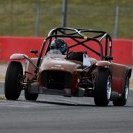Leaderboard
Popular Content
Showing content with the highest reputation on 18/11/15 in Blog Entries
-
Found out that the engine would hit the chassis if I put the diff where I intended to. A***. This meant some hunting through the spares pile and a bit of Googling - turns out Mazda use the same CV joints and spline pattern on the 1.6 and 1.8 Mk1 cars, but the 1.8s have 20mm shorter half shafts... This meant I could swap the NS drive shaft to a 1.8 model, shift the diff over 10mm, and it now clears, happy days! Knocked up a build table - a big sheet of MDF, some old beams from some pallet racking and a bit of chipboard underneath to brace it all. Solid, flat and weighs 110kg! Had a weekend away at the Race of Remembrance - an amazing event and won Class C, bonus! Ordered MSA compliant roll hoop and other bits of CDS tubing for the braces and harness bar - great service from Tom at tube-bender.co.uk. Diff came back from converting by Douglas at Westgarage Engineering. I spent a few hours pondering how to do it and it's not as simple as it first seems, so sent it to him... Cracking job, not cheap cheap but good value I'd say, given my lathe wouldn't be man enough for the task and there's a lot of work in it. 16T front and 54T sprockets, for 530 chain (big beefy b*******, sprockets are a touch under 9mm thick!). Total weight 12kg, so a good chunk saved there over having a full casing and crownwheel/pinion. Chassis arrived today. Well, I say chassis... Decided to go balls out and go for round tubing. Much harder to work with but should end up lighter and stiffer than box. So decided I needed a bit of help to get all the joins nice and tight... First tester - done a few of these now to do some practice welding tonight. Find doing round tubes quite tricky at the moment, so plenty of test runs needed - have found a few tips online so going to give them a go. Also updated the chassis design a touch, worked out how to mount the diff, ordered a chain, and spoke to a local fabricator about extending my headers... At the moment it fouls the billet sump, but chopping and adding 20-25mm into them should do it. What's making it tricky is that the tubing is titanium, but it can be sorted. The other option is a dry sump - but then you need remote electric water pump and controller, and all the other plumbing / tanks - suddenly adds a fair bit of cost and complexity, so not keen to go down that route really. Will update again in a few weeks, hoping to get cracking properly now, should have some bits of chassis tacked up for next time1 point
-
Back in July 2015 my Sport E electric Westfield was very badly damage due to a 'racing incident' at the Curborough sprint circuit. The car rolled three times and in the process ripped off or bent all four corners of the car. None of the wishbones, uprights or wheels escaped undamaged. In addition all the bodywork was broken in some way. On the face of it this was a total loss situation. However, amazingly all the electrical systems, motor and battery remained undamaged and in full working order. Fortunately I work for Potenza Technology. We had worked on a number of Westfield related design and development projects in the past. As a result Potenza were able to find a complete set of suspension parts and enough body panels to make the rebuild possible. The first job was to strip the car down to the chassis and check its condition. The main battery was hard mounted within the engine bay and so must have strengthened the chassis because it proved to be completely straight. On the other hand the wishbones and mounting clevises must have absorbed the crash forces. Also five suspension mounting clevises were either bent or ripped in some way and would need replacing. So with a bit of welding and a lot of kit building and the car could be back on the road again quite soon. But here's the problem - apart from my lack of driving skill, one of the reasons the car crashed in the first place must be to do with the unusual weight distribution. The engine bay battery weighs in at 160Kg. The motor, power controller, battery charger and cooling system were all mounted behind the rear bulkhead. Thus about 100Kg of weight was carried mostly behind and above the rear axle line. This weighty rear end made the car over steer and I found it quite difficult to control. Plan B. The original car carried batteries in both the engine bay and in an under tray beneath the car. The under tray weighed in at 200Kg so order to lighten the car for 2015 I removed these and reconfigured the remaining engine bay batteries to maintain power levels. Thus the car was 200Kg lighter - and faster - and unfortunately less stable! So for the 2016 car I will revert to the under tray battery, remount the differential in the correct orientation, fit a prop shaft and mount the motor and power controller etc into the engine bay. I calculate these changes will increase overall weight by 50Kgs to about 720Kg all up. This should result in a better balanced car that's easier for me to drive - and when people ask, where is the electric motor? - instead of pointing to the back of the car, I can open the bonnet and say 'in the engine bay'.1 point


